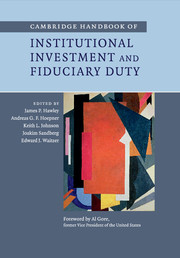Book contents
- Frontmatter
- Contents
- List of figures
- List of tables
- List of contributors
- Foreword
- 1 Introduction
- Part I Fiduciary duty: a global outlook
- 2 The public fiduciary: a Canadian perspective
- 3 The basis of fiduciary duty in investment in the United States
- 4 Governance and accountability in UK pension schemes
- 5 Institutional investment and fiduciary duty in Australia
- 6 The regulation of institutional investment in Sweden: a role model for the promotion of responsible investment?
- 7 The Dutch pension system
- Part II Fiduciary duty and the landscape of institutional investment
- Part III Challenging conventional wisdom on fiduciary duty
- Part IV Towards a broader interpretation of fiduciary duty
- Part V Beneficiaries’ roles and viewpoints
- Part VI Fiduciary duty and governance
- Index
- References
5 - Institutional investment and fiduciary duty in Australia
Published online by Cambridge University Press: 05 April 2014
- Frontmatter
- Contents
- List of figures
- List of tables
- List of contributors
- Foreword
- 1 Introduction
- Part I Fiduciary duty: a global outlook
- 2 The public fiduciary: a Canadian perspective
- 3 The basis of fiduciary duty in investment in the United States
- 4 Governance and accountability in UK pension schemes
- 5 Institutional investment and fiduciary duty in Australia
- 6 The regulation of institutional investment in Sweden: a role model for the promotion of responsible investment?
- 7 The Dutch pension system
- Part II Fiduciary duty and the landscape of institutional investment
- Part III Challenging conventional wisdom on fiduciary duty
- Part IV Towards a broader interpretation of fiduciary duty
- Part V Beneficiaries’ roles and viewpoints
- Part VI Fiduciary duty and governance
- Index
- References
Summary
Introduction
Australia has one of the largest pension fund systems in the world with $AUD 1.34 trillion in assets as at June 2011. The superannuation system is, however, not a single pool of assets but consists of different segments that have their own features in terms of the way members are recruited and serviced, and investments managed. The system is also divided in the way it is regulated with larger superannuation funds, with total assets of $AUD 810.6 billion, regulated by the Australian Prudential Regulation Authority (APRA) while self-managed superannuation funds, commonly referred to as SMSFs, with $AUD 407.6 billion in assets are regulated by the Australian Taxation Office (ATO). The market for APRA-regulated funds is itself divided between retail funds which held 28 percent of all assets whilst not-for-profits funds’ combined assets amount to 35 percent of the total assets. The core difference between retail funds and not-for-profit funds is that retail funds have been established by financial institutions with the objective of delivering an investment return to shareholders from offering superannuation products while not-for-profit funds, as their name suggests, do not have to deliver a return to shareholders.
The structure of Australia’s superannuation system
In Australia, superannuation fund members have the ability to select how their funds are invested as well as selecting which institution should invest on their behalf. At the request of a superannuation fund member a superannuation fund must be able to transfer superannuation assets to a newly selected superannuation fund within thirty days. The impact of choice in the Australian context is that there is significant competition among superannuation funds to recruit and retain superannuation fund members.
- Type
- Chapter
- Information
- Publisher: Cambridge University PressPrint publication year: 2014

